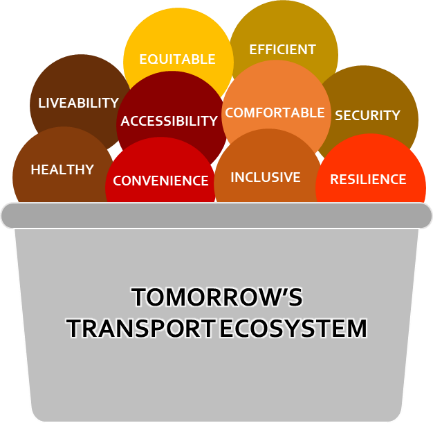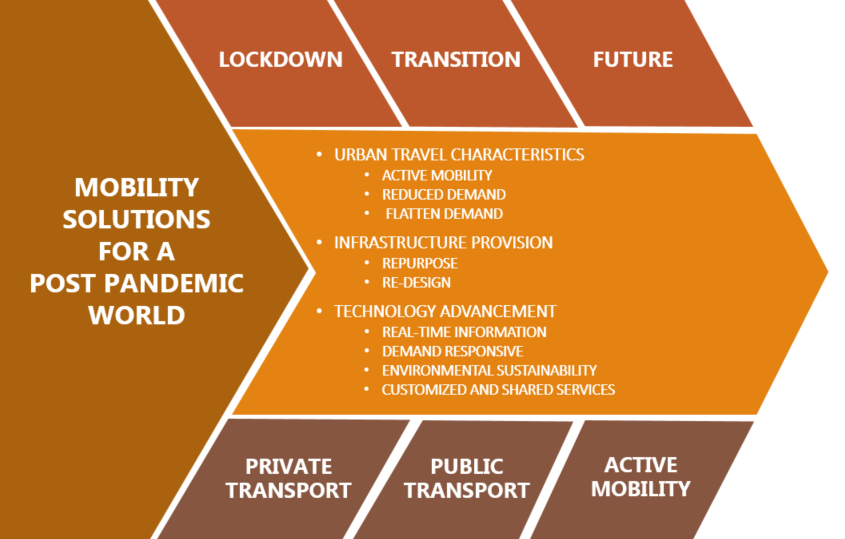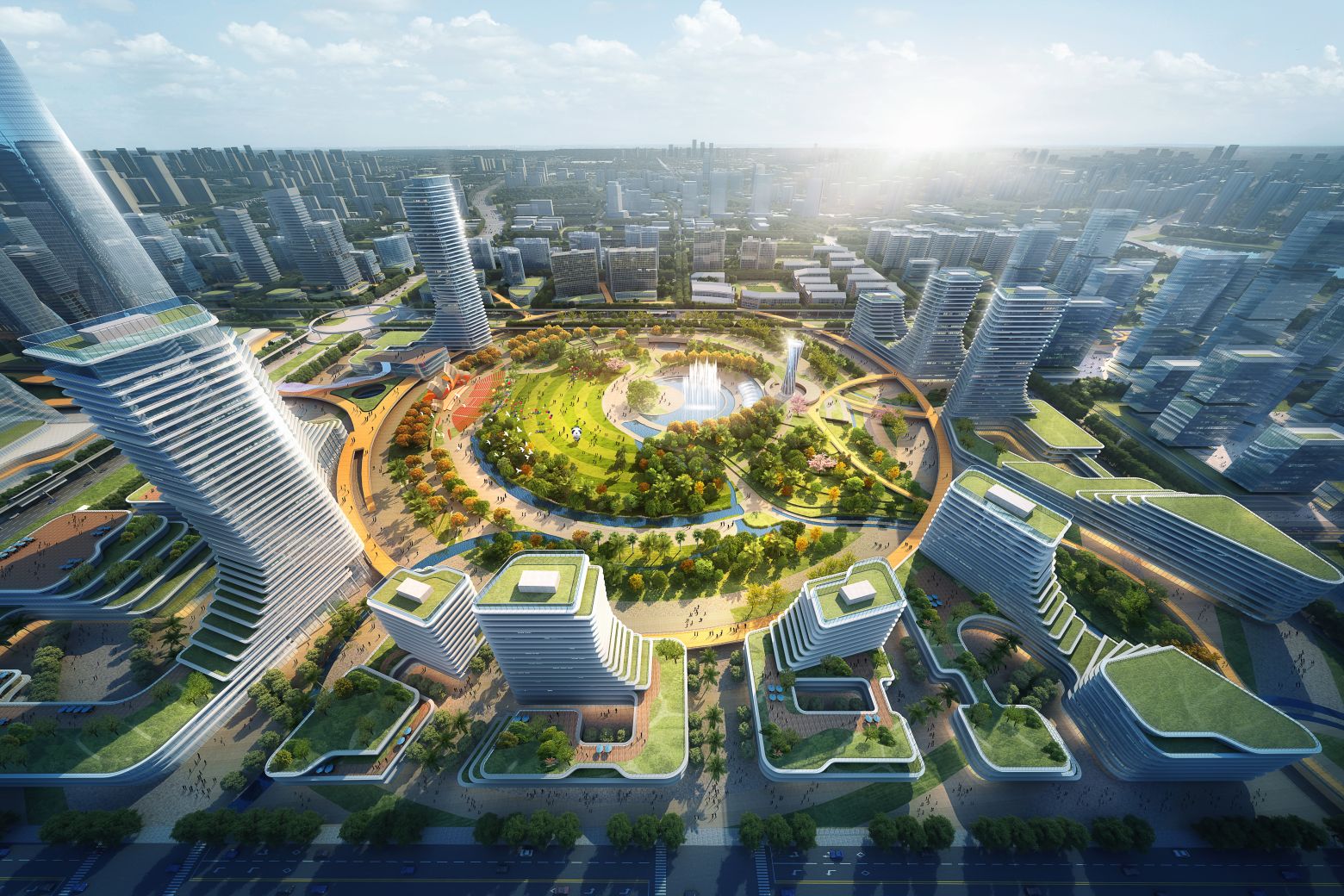
As companies and schools switched predominantly to digital platforms for activities during COVID-19 and non-essential trips are discouraged, there is a significant paradigm shift in travel characteristics of people. Different modes of travel, changes in time, and durations, as well as purposes of travel have created a new norm, which the existing transportation networks will not be able to support optimally in terms of operations. There are growing interests to re-design or re-purpose existing infrastructure based on the lessons learnt during the pandemic, as well as an increased need to predict emerging trends of transport infrastructure in the face of the next possible pandemic. Pertinent questions then include which infrastructure needs to be re-purposed, the extent of changes needed, when transformation needs to take place, and whether the infrastructure is resilient enough to counter emerging challenges, etc.
This blog article aims to provide an overview on some observations on mobility amidst the COVID-19 pandemic in Singapore; how pandemics may shape or evolve new trends; as well as suggestions on how industry players can respond proactively to emerging trends by forming sustainable solutions aimed at achieving a resilient transport ecosystem.
Observations from the COVID-19 Pandemic
During the Circuit Breaker period in Singapore, (a local term coined for the lockdown during COVID-19), despite lower public transport ridership accounting for only a fraction of that during the pre-pandemic times, the frequencies of trains and buses were still maintained at pre-pandemic levels to avoid overcrowding, a potential threat of airborne infection. Cleaner fleets, increased hygiene, reduced contact and safe distancing measures were introduced. Constant monitoring was also done to ensure that risks were minimised. Apart from public transport, there was also a surge in personalised travel modes such as private cars or taxis to maintain safe distancing.
Another significant trend observed was the increase in delivery vans and micro-mobility devices on the roads, estimated at 60% more than usual, as more people resorted to purchasing groceries and essential items online.
As a result of these travel pattern changes, peak hour travel (which is the leading cause of traffic congestions) is significantly reduced. While living with lockdown rules, people have also suitably turned to active mobility for exercise or for making essential trips within their neighbourhoods.
While the pandemic is still ongoing and the full impact of the pandemic on the future development of transportation infrastructure is still largely unknown, the emergence of COVID-19 has highlighted the need for planning and designing transportation systems to be ready (or being able to be operated optimally) during and immediately after a pandemic. Moving forward, it is evident that the planning of future mobility needs to take into account a new dimension of pandemic resilience, amongst all other known dimensions of considerations, including safer roads, sustainable and resilient transport policies, prioritising active mobility and managing travel demand.

Essential elements for a better transport ecosystem of tomorrow
These shall be discussed in three broad areas:
- Urban Travel Characteristics
- Infrastructure Provision
- Technological Advancements
(1) Urban Travel Characteristics
Beyond mobility pattern changes and social distancing, as more people see the benefits that work-from-home has brought about, it is likely that upcoming public policies would encourage businesses to adopt work-from-home practices or implement more flexible working arrangements. These changes in travel patterns can help to stagger and flatten the travel demand during peak hours.
Progressively, the planning of transport infrastructures should be based on the new staggered and flattened transport demand, as well as being supported by other demand management measures. When that happens, we can intensify our urban development by simply repurposing the existing transport infrastructure to support the new travel demand with enhanced public transport networks.
To ensure public transport remains the cornerstone of the transport ecosystem, there is a need to develop long-term commuter management frameworks, adapting services and customer communication with the right technology systems in place. This should also be supported by a robust, Active Mobility network which plays an essential role in the first and last-mile connectivity, often neglected in conventional transport planning in the past. The Active Mobility network will have to be integrated into a comprehensive multi-modal transport network involving the public transportation system, private cars, and personalised mobility services. It is now acknowledged by most, that a world-class transportation system should include a safe and efficient active-mobility network that integrates walkability and bike-ability seamlessly with public transport.
(2) Infrastructure Provision
To accommodate the urban travel characteristics discussed, we should look into repurposing the current road transport infrastructures to cater for non-motorised trips that are sustainable and resilient, not only for leisure, first and last-mile connectivity, but also for the last-mile delivery completed mostly with micro-mobility devices. In 2019, the Singapore Land Transport Authority (LTA) announced plans to increase the country’s cycling path network to 1,000 km by 2040. With the growing popularity in cycling observed during the pandemic period, this target should be reviewed with conscious efforts being invested in planning and provision of better facilities for active travel. This will also encourage the revision of vehicle growth rate to neutral, in line with Singapore’s Car-Lite policy (which aims to reduce Singaporeans’ reliance on cars and promote the use of sustainable alternatives).
When planning for land use, forward-thinking is essential. In terms of a mobility strategy, there can be two approaches: First, planning for more decentralised urban centres to encourage short trips within a self-sufficient town through the use of active mobility travel options. Second, by using the Transit- Oriented Development (TOD) concept in planning to connect the urban centres with the intensifying development around the MRT stations, so that any travel between towns or districts are comfortable, convenient, and sustainable. To achieve this, concerted efforts will be needed to undertake comprehensive transport planning and design of an eco-mobility system aimed at creating a “Zero-Carbon City of Tomorrow”.
(3) Technological Advancements
The accessibility to Big Data plays a pivotal role in transportation planning work, providing further insights to planners and operators, on the irregular demands observed through evolving travel patterns. This information offers more insight for stakeholders to formulate sustainable and innovative solutions through dynamic routing algorithms and demand-responsive service models. Industry players should continue to leverage such technological advancements to enhance the effectiveness and productivity of working from home. Another area that should be actively looked into would be the exploration of real-time technology in managing traffic performances.
At the national level, autonomous vehicle technology is one of Singapore’s visions for Transport. To have different modes of transportation seamlessly connected into one single, integrated network platform that is public transport-centric, it is vital to dedicate more pro-active research into the Autonomous, Connected, Electrified and Shared (ACES) vehicles as it transforms the conventional mobility of cities into the Mobility as a Service (MaaS) model. By right-matching demand and supply more efficiently, recent technologies will enable us to transform our transport infrastructure to being multi-functional over time.

Key Ideas of the Mobility Solutions for a Post Pandemic World
Despite the unprecedented COVID-19 storm, we can say that the reduction of cars on the road due to the pandemic situations is a silver lining in terms of air quality improvements and decrease in collision rates. Thinking positively, the pandemic creates an opportunity to reimagine and recreate future mobility, not only to serve as a connection between origin and destination, but also to enhance the overall travel experience of individuals. The transport infrastructure needs to be repurposed and redesigned to support future mobility with more sustainability and efficiency, possibly through technology evolution. We envisage that the future mobility ecosystem will be one that is green, integrated, automated, shared and demand-responsive. The days of merely planning transport infrastructure to meet forecast travel demand (often resulting in undesired outcome of traffic congested cities) are behind us. Instead, we should attempt a mixture of “incentivise” and “demotivate” approaches to influence travel characteristics, so that the right travel demand can be planned to meet an optimally-designed eco-mobility infrastructure.
[Related: Pandemic Resilient Solutions for the Built Environment]This article was authored by:
Ar. Mak Chin Long, Senior Vice President
Transport Division, CPG Consultants Pte. Ltd.
mak.chin.long@cpgcorp.com.sg
Ng Jing Wen, Senior Transportation Engineer
Transport Division, CPG Consultants Pte. Ltd.
ng.jingwen@cpgcorp.com.sg
Buddhi Abeyweera, Senior Principal Transportation Engineer
Transport Division, CPG Consultants Pte. Ltd
Buddhi.Abeyweera@cpgcorp.com.sg
Pooja Shashikant Yeola, Transportation Engineer
pooja.shashikant.yeola@cpgcorp.com.sg


